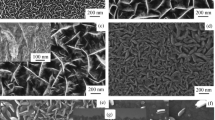Abstract
The kinetics of molybdenum sulfidation have been studied in H2S/H2 gas mixtures at 1173 K. Sulphur partial pressures were controlled by the equilibrium reaction between H2S, H2, and S2. Pure molybdenum metal was sulfidized at a fixed\(p{_S} _{_2 } \) value of 133 Pa with varying H2S and H2 partial pressures, and at fixed H2S partial pressures of 5.06×10 pa4 and 5.06×103 Pa with varying hydrogen and sulfur partial pressures. The gravimetric sulfidation kinetics were parabolic under all conditions. X-ray diffraction analysis of the reaction product scale revealed the presence of MoS2 only. The sulfide scales were of uniform thickness, had a compact morphology, and were tightly adherent to the metal. The sulfidation rates at a fixed sulfur partial pressure increased with increasing hydrogen partial pressure. At fixed\(p{_H} _{_2} {_S} \) values, the rate was almost constant at high\(p{_H} _{_2 } \) values, but increased substantially as\(p{_H} _{_2 } \) was decreased. Defect models for hydrogen dissolution in MoS2 are developed and compared with the experimental results. It is concluded that the sulfidation rate effects are due to hydride anion occupation of interlayer sites in MoS2.
Similar content being viewed by others
References
K. N. Strafford, G. R. Winstanley, and J. M. Harrison,Werkstoffe Korros. 25, 487 (1974).
D. J. Young, W. W. Smeltzer, and J. S. Kirkaldy,Met. Trans. 6A, 1205 (1975).
K. Fueki, H. Ishibashi, and T. Mukaibo,J. Electrochem. Soc. Jpn. 30, E23 (1962).
J. Gerlach and H. J. Hamel,Metall. 24, 1, 488 (1970).
K. N. Strafford and D. Jenkinson, “The High Temperature Degradation of Some Refractory Metals in Hydrogen-Sulphur Atmospheres,” inCorrosion Resistant Materials for Coal Conversion Systems, D. B. Meadowcroft and M. I. Manning, eds. (Applied Science Publishers, London, 1983).
K. N. Strafford, A. F. Hampton, and D. Jenkinson, inHigh Temperature Alloys — Their Exploitable Potential, J. B. Marriott, M. Merg, J. Ward, and J. Nichoul, eds. (Elsevier Applied Science, London, 1987).
M. Farber and D. M. Ehrenberg,J. Electrochem. Soc. 99, 427 (1952).
B. S. Lee and R. Rapp,J. Electrochem. Soc. 131, 2988 (1984).
M. S. Koval'chenko, V. V. Sychev, D. Z. Yurchenko, and Yu. G. Tkachenko,Russ. Metall. (Eng. Transl.) 5, 180 (1974).
J. E. Dutrizac,Can. Metall. Quar. 9, 499 (1970).
B. S. Lee, Ph.D. Thesis, (Ohio State University, 1980).
JANAF Thermochemical Tables (Dow Chemical Company, 1965).
R. Frivaz and E. Mooser,Phys. Rev. 163, 743 (1967).
M. R. Hilton and P. D. Flesischauer,J. Mater. Res. 5, 406 (1990).
F. A. Kroger and H. J. Vink,Solid State Physics, Vol. 3, F. Seitz and D. Turnbull, eds. (Academic Press, New York, 1956).
H. Rau,J. Phys. Chem. Solids 41, 765 (1980).
Y. Suzuki, T. Uchida, W. Wakihora, and M. Taniguchi,Mater. Res. Bull. 16, 1085 (1981).
C. Wagner, inAtom Movements (ASM Cleveland, 1951), p. 53.
Author information
Authors and Affiliations
Rights and permissions
About this article
Cite this article
Cheung, W.H., Young, D.J. Hydrogen doping effects in the sulfidation of molybdenum. Oxid Met 36, 15–25 (1991). https://doi.org/10.1007/BF00938454
Received:
Revised:
Issue Date:
DOI: https://doi.org/10.1007/BF00938454



